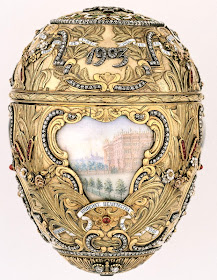Next in line though, we have the "Peter the Great Egg", from 1903!
In 1703 Peter the Great founded St. Petersburgh, and this rococo-style egg was made to celebrate the two-hundreth anniversary of this occasion. Made out of varicolored gold, diamonds, and rubies, this egg is full of symbols. On one side sits the portrait of Tsar Nicholas II...
...While on the other side you find a portrait of Peter the Great. In Russia roses and laurel leaves represent triumph and pride, and the bullrushes are there to symbolize the marshy land upon which Peter the Great built St. Petersburg - named after himself.
Except for the two portraits there are two other watercolors on the egg - painted on ivory and covered with rock crystal instead of glass. Under the date 1903, set in diamonds, is the 1,000-room Winter Palace, with the text "The Winter Palace of His Imperial Majesty in 1903" on a white enamel ribbon beneath it. On the other side is a miniature of the wooden hut that is traditionally said to have been built by Peter the Great himself. Underneath the ribbon reads: "The first little house of the Emperor Peter the Great in 1703". On two other ribbons is written the texts: "The Emperor Peter the Great, born in 1672, founded St. Petersburg in 1703", and "The Emperor Nicholas II, born in 1868, ascended the Throne in 1894".
This egg's surprise becomes visible when it's top is opened. Then a mechanism on the inside raises into position from the lower half of the egg a miniature model in gold of Peter the Great's monument on the Neva, made by Gerogii Malychevin, resting on a base of sapphire.
Here's the original, created by the French sculptor Etienne Maurice Falconet...
...And here we have the miniature copy! The reason this was chosen to be the surprise is that legend says enemy forces will never take St. Petersburg as long as the "Bronze Horseman" stands in the middle of the city.
The last private owner of the "Peter the Great Egg" was Lillian Pratt, who in 1947 bequeathed it to the Virginia Museum of Fine Arts. The egg now remains on permanent view in their European Decorative Art Collection.






I love the little horseman!! Precious and beautiful! xx
ReplyDeleteAmazing egg Miss Meadows. I'm with Doll, I love it!
ReplyDelete